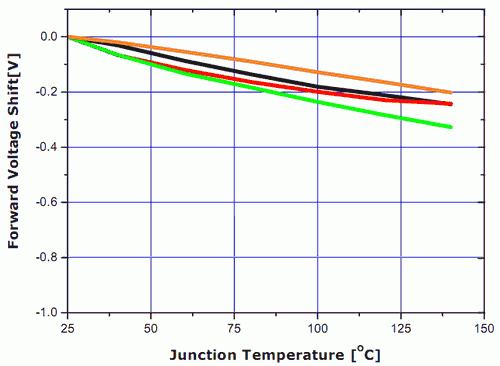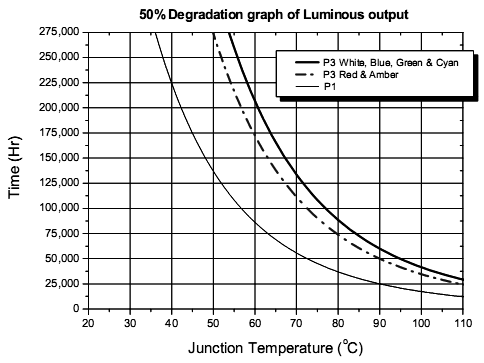Temperature instability of LED current
If voltage on LED contacts is kept constant but its temperature rises, current flowing through an LED
will rise as well. This phenomenon is common to all types of semiconductor materials and it can be
accredited to rise in mobility of carriers of electrical current (electrons and holes) at higher
temperatures. Since the converter presented here is built so that it keeps the output voltage constant,
and having in mind that powerfull LEDs suitable to bicycle headlights dissipate watts of power, this
means that after merely a few seconds LED current would start to rise noticeably. The next diagram shows
that relative increase of LED current is rather steep - if no measures were taken against this
phenomenon, precious multi-watt LEDs could easily vanish in smoke after a minute or two.

But fortunately the converter was designed to be up to the task. The key component for temperature
stabilisation is transistor Q1. In output voltage regulation chain, it acts as a triggering element
that constantly compares LED voltage to a stable reference voltage of 2.5V produced by TL431.
LED voltage is fed to Q1 emiter through a voltage divider formed by sensing resistors; if it rises
more than 0.6V above Q1 base voltage i.e. the reference voltage, Q1 starts to conduct. That activates
comparator U1 which then stops MOSFET transistor Q3 decreaseing consequently the output voltage.
Temperature dependence of Q1 emitter-base junction voltage is negative which means that its activaiton
will tend to limit LED voltage to lower values at higher temperatures. And this is exactly what is
necessary in order to keep LED current reletively constant with respect to temperature changes!
It is obvious that the circuit should be mechanically constructed so that Q1 can be positioned near
the output LED in order for it to able to sense changes in its temperature. Regulation is not perfect,
but it is more than enough for the target applicaiton of the device.
Overclocking LEDs
LED lifespan is typically specified as the number of operating hours after which it is expected that
its efficacy falls to 50% of the original. It is assumed that both LED current and temperature stay
below maximum specified values during operation. As of 2010, a typical lifespan of high power LEDs
when driven at full specified power is 100,000 hours - more than 10 years of continual operation
before their efficacy falls to 1/2 of the original. That is about 100 times better than a typical
incandescent light bulb! If operating underpowered, LEDs will certainly last a lot longer and vice
versa, as depicted on the next diagram.

Ten years of uninterrupted lighting sounds great, but wait a minute. Is there a single cyclist in the
world that has ever accumulated 100,000 hours of night cycling? Hmm... As the answer is probably "NO",
then perhaps we are in the position to drive LEDs in bicycle headlights a bit harder than recomended
by manufacturers, so that we get some more photons despite the somewhat shortened LED lifetime?
The above diagram specifies expected LED lifespan versus its operating temperature. Without digging
too deeply into equations, it can be argued that LED temperature is linearly proportional to its
power disipation, which is again proportional to LED current. Since LED chip degradation
due to high operating temperature is the dominant failure mode of semiconductor materials used for
making white LEDs, we are able to use the diagram to estimate how much we can be rough on our LEDs
and still be able to expect them to last a certain number of hours. LED headlight designers and
users should be, however, aware of the fact that LED efficacy drops significantly at higher than
normal temperatures, so too much overpowering is unlikely to be that much useful.
In practice, overpowering LEDs as much as 50% above the specified maximal current doesn't seem to
degrade their efficacy noticeably over several years of regular use as night cycling light sources.
Obviously, it is of paramount importance to provide very efficient cooling to LEDs operating
under such stress. By enabling LEDs to operate at lower temperatures while disipating a certain
amount of heat power, effective cooling both makes diodes operate at high luminous efficacy and prolongs
their usable lifespan. It is up to the user do figure out whether higher light flux or longer
LED lifespan is preferred in a particular headlight design. The most practical solution is to
enable two or more power settings in a headlight - the weakest one will be sufficient for cycling
in urban conditions whereas the stronger ones will be suitable for cycling on dark countryside roads.
In convertor diagram presented in this article, LED power can easily be set by adjusting a single
resistor value.


